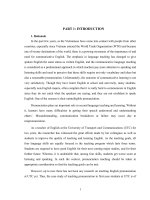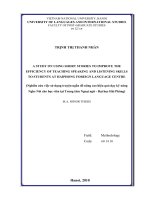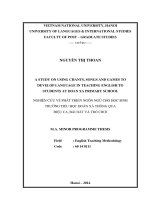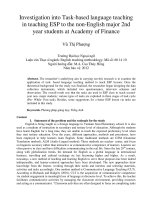A STUDY ON USING PHONICS METHOD IN TEACHING PRONUNCIATION TO THE BEGINNERS OF ENGLISH AT TIENGANH123 ENGLISH CENTER
Bạn đang xem bản rút gọn của tài liệu. Xem và tải ngay bản đầy đủ của tài liệu tại đây (644.34 KB, 48 trang )
!"#$%&'(
)*&+,-./(
01*+12
33
456789:64;<5=><49:5?<@7@6@:A
@758BCDC
CE
!"#$%&'(
)*&+,-./(
01*+12
33
456789:64;<5=><49:5?<@7@6@:A
@758BCDC
FG5HI4;@H8 H3JKLML
CE
I herby certify that thesis entitles “A study on using Phonics method in
teaching pronunciation to the beginners of English at TiengAnh123 English center”
is my own study in the fulfillment of the requirement for the Degree of Master of
Arts at Faculty of Post- Graduate Studies, University of Languages and
International Studies, Vietnam National University, Hanoi.
Hanoi, 2015
Luong Thi Hoai Phuong
i
The purpose of this study is to explore whether using phonics to teach
pronunciation can help English beginners better at pronunciation. It has two foci.
One is to investigate whether phonics method can help English better in
pronunciation or not. The other is to identify the situation when the phonics
instruction is implemented in the classroom. This study employed a qualitative and
quantitative approach in which it primarily relied on the use of action research.
Eighteen students from English123 center participated in the study. The findings of
the current study revealed that phonics instruction has positive effect on English
beginners in leaning pronunciation; however, it is still problematic. Even though
Phonics could help students pronounce consonant well, most of students feel
confused with pronouncing the vowels and diphthongs. The reason is that there are
too many spelling rules for each sound to remember.
ii
NO
I would like to express my most sincere gratitude to my respectable supervisor,
Dr. Ha Cam Tam, for her restless and sympathetic encouragements, valuable
advice and patient guidance until the completion of this study.
My sincere thanks also go to my dear colleagues at Tienganh123 English
Center for all their help, support and encouragement when I encountered
difficulties.
I wish to acknowledge my thankfulness to the pronunciation class for their
enthusiastic participation in this project.
Finally, I am deeply indebted to my beloved parents, my siblings and my post-
graduate friends for their sacrifice, encouragement and care.
iii
Certification of originality i
Abstract ii
Acknowledgement iii
Table of contents iv
Tables vi
Figuresv vii
8333333333333333333333333333333333333333333333333333333333333333333333333333333331
1.Rationale 1
2. Research hypothesis 2
3.Aim of the study 2
4.Significance of the study 2
5.Scope of the study 3
6.Methodology of the study 3
7.Organization of the study 3
83333333333333333333333333333333333333333333333333333333333333333333333333333333334
8O33333333333333333333333333333333333333333333333333333333333334
1.1. Phonecs 4
1.2. English phonecs 5
1.3. Phonics 7
1.3.1. Definitions of phonics 7
1.3.2. Review of previous studies 10
1.4. Action research 11
1.4.1. Definitions of action research 11
1.4.2. Steps of action research 12
8333333333333333333333333333333333333333333333333333333333333333333333333333333313
2.1. The setting of the study 13
2.2. Research design 13
2.2.1. Participants 13
2.2.2. Data collection instruments 13
iv
2.2.3. Data collection procedure 15
2.3. Data analysis and discussion 18
2.3.1. Observation 19
2.3.2. Reflection 22
833333333333333333333333333333333333333333333333333333333333333333333333333333333333324
1.Major findings 24
2.Implications 24
3.Limitations of the study 25
4.Suggestion for further studies 25
333333333333333333333333333333333333333333333333333333333333333333333333333333333333333333333333333326
Appendix A: Pre-test I
Appendix B: Test 1 II
Appendix C: Test 2 III
Appendix D: Test 3 IV
Appendix E: Test 4 V
Appendix F: Post-test VI
Appendix G: Lesson plan sample VII
v
Tables 1: English consonant sounds……………………………………………….7
Table 2: Comparison of Phonics and Phonetics……………………………………7
Table 3: Comparison of Phonics and Phonetics……………………………………8
Table 4: Examples of spelling rules in phonics instruction ………………………17
Table 5: Examples of list of words without initial consonants……………………18
vi
Figures 1: English vowel sounds………………………………………………… 7
Figure 2: Comparison of the mean scores of four regular tests……….………… 22
Figure 3: Comparison between the mean scores of Pre-test and Post-test……… 23
vii
8
3=?4@9=65
Pronunciation instruction is important factor in foreign language teaching. As
sounds play a crucial role in communication, foreign language teachers must
attribute proper importance to teaching pronunciation in their classes. It is evident
that communication is a mutual relationship between the speaker and hearer. This
means that one must comprehend what he/she hears in the target language and must
produce the sounds of the language he/she must trying to learn accurately. Unless
he has sufficient knowledge of the sounds of the target language, he can neither
encode a message to anybody nor decode the message sent by another person by
learning the sounds of the target language within his mother tongue. Therefore,
pronunciation instruction is of great importance for successful oral communication
to take place since it is an important ingredient of the communicative competence.
(Hismanoglu, 2006). Hamers (2007) identifies the importance of pronunciation
instruction as “Pronunciation teaching not only makes students aware of different
sounds and some features, but can also improve their speaking immeasurably”
(p.248). Celce-Murca, Brinton, and Goodwin (1996) claim that none-native
speakers of English need to achieve a “threshold level of pronunciation” to be
understood and minimize oral communication problems (p.3). Pronunciation needs
to be taught and deserves more attention in a language course.
However, without a systematic syllabus, many students have difficulties in single
word pronunciation. Even though some students have learned English for years
before they enter junior high school, they were unable to read orally and spell out
most of the words. Very often, when teacher asked them to read words or sentences,
they just closed their mouths and kept silence.
There have been many approaches to teach English pronunciation discussed and
elaborated worldwide, and these include whole language, phonetic symbols and
computer assisted programs. Yet there is no research that has been taken in Vietnam
1
to assess the effectiveness of using phonics in helping students to learn English
pronunciation. This action research project begins to address this need.
Since English is a universal language that has been widely used, learning English
becomes a globalized trend. Due to this reason, students in Vietnam started learning
English at an early age. However, after a long English learning period, many
students still have difficulties in communicating in English and show less proficient
English competence and performance that led to a miscommunication in English.
As Hung (2004) indicated, this situation was caused by their inability to pronounce
words, namely, a failure in understanding the correlation between letters and sounds
it stands for, and hence, resulted in students’ failure in understanding the text or
even no intention to understand the text. This problem revealed that English
teaching and learning in Vietnam has put much more emphasis on grammar and
vocabulary that the way to communicate. Thus, a lack of basic ability in accurate
pronunciation was common for students. In order to explore better solutions for
these problems, it is necessary for teachers to come to an approach to better students
in learning English, especially pronouncing English words.
35;5=H><<AG@?<5;4;
In the present study, I hypothesized that students can pronounce words better with
the help of phonics instruction.
34L;@P?<5;?F7A
The aim of the study is to find out whether student can develop their ability of
pronunciation with the help of phonics instruction.
D3<5;4:94P4>=9>5@P?<5;?F7A
This study is hoped to bring some benefits to both teachers and students as follows:
•It may stimulate teachers to employ a new method for teaching English
pronunciation
•It may stimulate students and help them to improve the pronunciation ability.
2
E.<5;>@G5@P?<5;?F7A
As could be seen from the title of the study, this paper investigates the use of
phonics instruction in teaching English pronunciation. At the same time, the study
only concentrates on English learners at elementary level. Furthermore, the study
was conducted at an English learning center.
B35?<@7@6@:A@P?<5;?F7A
The action research approach was employed in this study.In addition the tests were
given to find out in-depth data about students’ progress and ability of pronouncing
words.
Q3H:=94R=?4@9@P?<5;?F7A
This study is divided three parts which discuss the following matters:
=H?89?H@7F>?4@9 presents a brief introduction of the rationale, the aims, scope,
significance, method and organization of the study.
=H?85I56@GL59?
Chapter 1: 4?5H=?FH55I45S provides the theoretical knowledge and results from
the recent studies for the issues relevant to the field under investigated. First
phonetics and English phonetics were reviewed. Second, previous studied related to
phonics instruction will be reported.
Chapter 2: <5;?F7A is composed of three sections. First, the setting of the study
including the context and participants will be described. Next, the model of action
research in this study is provided. Finally, the data analysis and discussion are
presented.
=H?8@9>6F;4@9 summarizes the major findings, the implications and presents
the limitations of the study, and suggestions for further studies.
3
8
8O
This chapter was partitioned into four main parts. First, the phonetics was explored.
Second, the English phonetics was reviewed. Third, phonics instructions and the use
of phonics instruction were shown. Finally, the review of action research was
presented.
33<@95?4>;
Phonetics is a branch of linguistics that comprises the study of sounds of human
speech. It’s concerned with human noises by which the thought is actualized or
given audible shape: the nature of these noises, their combinations, and their
functions in relation to the meaning. Phonetics is subdivided into practical and
theoretical. Practical or normative phonetics studies the substance, the material form
of phonetic phenomena in relation to meaning. Theoretical phonetics is mainly
concerned with the functioning of phonetic units in the language. Theoretical
phonetics regards phonetic phenomena synchronically without any special attention
paid to the historical development of English.
According to Carr, Philip (2003), phonetics provides objective ways of describing
and analyzing the range of sounds humans use in their languages. More specifically,
articulatory phonetics identifies precisely which speech organs and muscles are
involved in producing the different sounds of the world’s languages. Those sounds
are then transmitted from the speaker to the hearer, and acoustic and auditory
phonetics focus on the physics of speech as it travels through the air in the form of
sound waves, and the effect those waves have on a hearer’s ears and brain. It
follows that phonetics has strong associations with anatomy, physiology, physics
and neurology (McMahon, 2002).
Three traditional branches of the subject are generally recognized:
Articulatory phonetics is the study of the way speech sounds are made by vocal
organs. It studies the way in which the air is set in motion, the movements of the
4
speech organs and the coordination of these movements in the production of single
sounds and trains of sounds.
Acoustic phonetics studies the physical properties of speech sound, as
transmitted between the speaker’s mouth and the listener’s ear.
Auditory phonetics studies the perceptual response to speech sounds, as
mediated by ear, auditory nerve and brain. Its interests lie more in sensation of
hearing, which is brain activity, than in the psychological working of the ear or the
nervous activity between the ear and the brain. The means by which we
discriminate sounds – quality, sensations of pitch, loudness, length, are relevant
here.
Phonetics is the study of how speech sounds are made, transmitted, and received,
i.e. phonetics is the study of all possible speech sounds. The human vocal apparatus
can produce a wide range of sounds, but only a small number of them are used in a
language to construct all of its words and utterance.
339:64;<G<@95?4>;
In English, there is no on-to-one relation between the system of writing and the
system of pronunciation. The alphabet which is used to write English has 26 letters
but in (Standard British) English there are approximately 44 speech sounds
including 12 vowels, 8 diphthongs and 24 consonant sounds.
3339:64;<I@S56;@F97;
In phonetics, a vowel is a sound in spoken language, such as English “ah!” [a:],
pronounced with an open vocal tract so that there is no build-up of air pressure at
any point above the glottis. According to Roach (2000:10), vowels are “sounds in
the production of which there is no obstruction to the flow of air as it passes from
the larynx to the lips”.
According to English phonetics and phonology, vowel was defined as
below:“Vowel is a speech sound in which the air stream from the lung is not
blocked in any way in the mouth or throat and which is usually pronounced with the
vibration of the vocal cords.”
5
Here under is the vowel chart:
Figure 1: Vowel sounds chart
A diphthong, literally "two sounds" or "two tones", also known as a gliding vowel,
refers to two adjacent vowel sounds occurring within the same syllable.
Technically, a diphthong is a vowel with two different targets: that is, the tongue
moves during the pronunciation of the vowel.
333@9;@9=9?;@F97;
According to the Oxford Advanced Learner’s Encyclopedic (1992:192), consonants
are “speech sounds made by completely or partly stopping the flow of air breathed
out through the mouth”. In Wikipedia Dictionary, it is said that “the number of
consonants in the world’s languages is much greater than the number of consonant
letters in any one alphabet”. In English phonetics and phonology (Roach, 2000:10),
the term consonant can be defined as “sounds in which there is obstruction to the
flow of air as it passes the larynx to the lips”. One more collected definition from
the lectures: The production of sounds, consonant was defined as: “Consonant
sounds are the sounds, in the production of which one articulator moves towards
another or two articulators come together obstructing the air stream and the air
stream can’t get out freely.”
According to Marianne, Donna and Janet (1996:42,43), the consonants system was
classified according to place and manner of articulation.
6
According to the slide shared by Goodwin (2006), place of articulation was defined
as “the location of the obstruction of the air stream in the articulation of consonants.
It describes the point at which the articulators actually touch or at their closest.”
Here under is the chart of classification of English consonant sounds.
Table 1: English consonant sounds
33<@94>;
3335P494?4@9;@PG<@94>;
Phonics, conventionally defined as correspondent relationships between letter and
sounds. It is a method to develop reading ability in English speaking countries.
(Chou, 2010).
What is the difference between phonics and phonetics? Dictionary.com has the
following entries:
<@94>; <@95?4>;
A method of teaching elementary
reading and spelling based on the
phonetic interpretation of ordinary
spelling.
The branch of linguistics that deals
with speech and their production,
combination, description and
representation by written symbols.
The system of sounds of a particular
language.
Table 2: Comparison of Phonics and Phonetics
(The American Heritage Dictionary of the English language)
7
<@94>; <@95?4>;
The science of sounds: acoustics
A method of teaching beginners to
read and pronounce words by learning
the phonetic value of letters, letter
groups and especially syllables.
A study and systematic classification
of sounds made in spoken utterance.
The practical application of this
science to language study.
The system of speech sounds of a
language and a group of language.
Table 3: Comparison of Phonics and Phonetics
(Merriam –Webster Medical dictionary)
There are different points of view on phonics. Some regard phonics as a kind of
relationship between information about or association with letters and sounds, some
regard phonics as one of the teaching methods and some others relate phonics to
reading instruction (Hung, 2004). As Durkin (1993), phonics refers to a “body” of
information about connections between letters and speech sounds which are
designed to help readers figure out the pronunciation of words unknown in their
written form.
Different from this view, Richard, Platt (1998) pointed out that phonics is a method
of teaching children to read. Children are taught to recognize the relationship
between letters and sounds. They are taught the sounds which the letters of the
alphabet represent, and then try to build up the sound of a new or unfamiliar word.
Besides, Adams (1990) considered that phonics is the instruction to help children
understand letter and sound correspondences in alphabetic language. Through
understanding and internalizing the correspondences, children recognize the printed
words in their oral vocabulary by sounding them out and discover the relationship
between speech patterns and spelling patterns. In other words, phonics develops
beginners’ capability to generalize the rules of letter-sound correspondences so that
they may be equipped with the skills to produce the pronunciation of unseen words
(Groff, 1989; Stuart, 1995). Thus, phonics aims to help children promptly recognize
familiar words and correctly decode those unfamiliar ones (Armbruster & Osborn,
2003). Stahl (1992) further mentioned that the purpose of phonics instruction is not
8
only to teach children not only sound out words, but to recognize words effortlessly
and automatically in order to transfer their attention to the meaning of the text.
Phonics instruction teaches students to understand and learn the relationship
between the letters (graphemes) of written language and the individual sounds
(phonemes) of spoken language. It also teaches children how to use these
relationships to read and write words accurately (Armbruster, Lehr, & Osborn, 2000).
The main goal of phonics instruction is for students to learn and use the alphabetic
principle –the understanding that there are systematic and predictable relationships
between written letters and spoken sounds (Armbruster, Lehr, & Osborn, 2000).
This principle helps greatly on children’s ability to read words, both in isolation and
in reading passages. Adam (1990) also claimed that phonics is instruction intended
to help children understand the fundamental alphabetic nature of English writing
system and through that understanding, to internalize the correspondences between
frequent spelling patterns and the speech patterns. In another study with Taiwanese
students, Shen (2003) states that EFL learners should have phonics instruction to
develop their phonemic awareness efficiently; which will lead to successful
automaticity in word recognition.
Phonics instruction provides students with adequate alphabetic rules to choose
among a set of possible candidate sounds, the correct pronunciation of the word
(Rogers, 1985). With the corresponding letter-sound knowledge in mind, students
are ready to venture in the authentic word hunt. As they apply their alphabetic rules
to test on the words that are of irregular form, although they may not be completely
correct in the first place, they have accessed to match the decoded phonological
information of the words to their known-word repertoire (Hu & Kai, 2000). The
more student venture in decoding unfamiliar words, the more trial and error
experiences facilitate them to establish the repertoire of word-specific, irregular
orthographic representation (Hu & Kai, 2000). When it comes to foreign learning, a
clear and understandable pronunciation plays a crucial role of a succesful
communication that helps speakers understand and be understood( Goodwin, 2001).
9
However, as far as foreign language learning is concerned, learning the ability of
pronunciation had long been ignored till recent decades. After 1980s, with the trend
of the communicative approach, comprehensible pronunciation has become an aim
in ESL and EFL classroom, focusing on fluent communication and clear expression
(Brown, 2007). Besides, since 1990s, pronunciation has been emphasized in the
field of English learning and teaching (ELT) (Celce-Murcia, Brinton & Goodwin, 2007).
3335I45S@PGH5I4@F;;?F745;
In the past few decades, research on teaching pronunciation through phonetic
symbols focused on comparing the effectiveness between phonics and phonetic
symbols. The results of these studies are different.
Some researches show that teaching pronunciation through phonics is more
effective (Huang, 2002; Hung, 1998). Fifth graders in Hung’s (1998) the phonics
group performed significantly better than those in the K.K. group in the oral
pronunciation test. The phonics group also showed more positive results regarding
their attitude and interest in learning English. On the same track, Huang (2002)
investigated whether or not junior high school students could be trained to foster
their phonological awareness through phonics instruction. The results indicate that
Phonics instruction has positive effects on first-year junior high school students’
acquisition of phonological awareness of first- year junior students Om the other
hand, some studies showed that the K.K phonetic system is more effective in terms
of pronunciation learning and instruction (Chu, 2006; Hsieh, 2009; Liu, 2009).
However, some studies show that there are no significant differences between
learners’ pronunciation performance, regardless of phonics or K.K. phonetic system
instruction (Hsu, 2003). Most studies show that leaner’s benefit from the
combination of both types of instruction (Chung, 2011; Hsu, 2000; Lin, 2001). Lin
(2001) explored the efficacy of phonics in teaching pronunciation to Chinese EFL
adult learners. Results from the tests revealed that the phonics approach as well as
the combination of phonics and the phonetic method was found to have a significant
effect in teaching pronunciation to EFL adult learners. Furthermore, Hsu (2000)
10
investigated the functions and application of phonics and phonetic symbols in
English leaning and teaching. The result indicated that phonics and phonetic
symbols are only two assisting tools and methods in pronunciation teaching. The
main teaching and learning method of English word pronunciation was through
direct imitation and practice.
In contrast to the positive result from phonics instruction, some studies show that
teaching pronunciation through phonetic symbols is more efficient. Chu (2005)
compared the effectiveness of teaching English phonics and phonetics symbols on
word pronunciation. The result indicated that student receiving phonic symbols
instruction outperformed those who received phonics instruction.
In summary, the results vary among different comparative studies on the effects
between phonics instruction and phonetic symbol instruction. Some show that
phonics instruction is more effective than phonetic symbol teaching. Some found
that there are no differences between these two methods. Some suggest that phonics
and phonetic symbols are both excellent tools in assisting young learners learning
English pronunciation. In contrast, some other studies show that a phonetic symbol
teaching is more effective than phonics instruction.
In Viet Nam, the phonetic symbol instruction has been a popular method used in
teaching pronunciation. Lately, phonics instruction is applied to teach in some
schools. Hence, in order to assist English teacher in Vietnam, it is necessary to
investigate teaching English pronunciation through phonics instruction.
3D3>?4@9H5;5=H><
3D335P494?4@9;@P=>?4@9H5;5=H><
Action research is a very popular research method in the current development of
society. However, different researchers have different ideas about what an action
research is. According to Nunan, D. (1992:18), a very famous researcher in the field
of education, “A descriptive case study of a particular classroom, group of learners,
or even a single learner counts as action research if it is initiated by a question, is
supported by data and interpretation, and is carried out by a practitioner
11
investigating aspects of his or her own context and situations”. This definition
shows that in order to carry out an action research, the teacher must be a practitioner.
She must identify the problem, and then carry out her plan to solve the problem.
Another definition given in Longman Dictionary of Language Teaching and
Applied Linguistics (2002:8) is that “Action research is teacher-initiated classroom
research that seeks to increase the teacher’s understanding of classroom teaching
and learning and to bring about improvements in classroom practices”. In other
words, action research aims to help teachers to improve their teaching and students’
learning in any aspects that they realize in their work.
Tsui (1993) stated that “Action research is a very effective way of helping teachers
to reflect on their teaching and to come up with their own alternatives to improve
their practices”. This is a very simple but detailed definition about action research.
Through all the definitions above, it can be concluded that action research is carried
out with the aim of solving practical problems in a classroom. It mainly focuses on
the actions of both teachers and students.
3D33?5G;?@>@97F>?=9=>?4@9H5;5=H><
According to Nunan (1992:19), there are seven steps to conduct and action research
including initiation, preliminary investigation, hypothesis, intervention, evaluation,
dissemination and follow-up. However, in this research, the researcher follows the
action research model of Kemmis and Mc Taggart (1988), which is composed of
four phases:
1. Planning: a problem or issue is identified and a plan of action is developed in
order to bring about improvements in specific areas of the research context.
2. Action: the plan is to put into action over an agree period of time.
3. Observation: the effects of the action are observed and data are collected.
4. Reflection: the effects of the action are evaluated become the basis for further cycles of
research.
8
12
This chapter presents a detailed description of process carrying out this study. First,
the setting of the study is given. Second, the research design is provided. Thirdly,
the data analysis and discussion including 2 phases: action, observation and
discussion are presented.
33<5;5??49:@P?<5;?F7A
The study was conducted at TiengAnh 123 English center which offers training in a
variety of English courses. The researchers surveyed learners who were studying in
pronunciation class. The learners were mainly university students along with some
employees in several companies in Hanoi. They voluntarily paid tuition fee to take
the course. The outstanding advantage of the target training was the keen interest of
these learners in English. Most of them were very studious and purposeful in
studying the pronunciation course.
335;5=H><75;4:9
333=H?4>4G=9?;
The study was carried out in the English 123 center in Hanoi. The implementation
of the research was carried out from June, 6
th
to July, 19
th
2014.
The subjects of the research were eighteen students at English 123 center in Hanoi
including 10 females and 8 males. They were at the age range of 19 to 26. They
were assumed to be at the beginner level of English proficiency.
333=?=>@665>?4@949;?HFL59?;
According to action research approach, data collection instruments are included in
the phase of planning. The following part will present the phase of planning clearly.
The research was carried out within four weeks in total. There were two
pronunciation sessions for each week. Each session lasted ninety minutes. In the
phase of planning, teacher prepared lesson plans for each session and six oral tests
to check students’ progress during the pronunciation course.
13
The phonics instructions used in the phase of planning are described clearly as
follows:
ON
Session 1: Short vowel sounds: /ɒ/, /ɪ/, /e/, /ʌ/, /æ/, /ʊ/
Session 2: Consonant sounds /b/, /p/, /t/, /d/, /h/, /m/ /n/
ON
Session 3: Consonant sounds: /l/ /r/, /f/, /v/, /dʒ/
Session 4: Consonant sounds: /k/, /g/, /j/, /s/, /z/
ON
Session 5: Consonant sounds: /ʃ/, /tʃ/, /θ/, /ð/, /ŋ /
Session 6: Long vowel sounds: /iː/, /ɔː/, /ɑː/, /uː/, /ɜː/
OND
Session 7: Diphthongs: /eɪ/, /aɪ/, /ɔɪ/
Session 8: Diphthongs: /əʊ/, /aʊ/, /ɪə/, /eə/
The oral tests were described clearly as follows:
There were six oral tests the pronunciation course. One pre-test, one post-test and
four regular tests were included. The pre-test was taken at the beginning of the
pronunciation course in order to check all participants’ English pronunciation
performance before the pronunciation instructions. The post-test was taken at the
end of pronunciation course in order to check students’ English pronunciation
performance after the pronunciation instruction. Four regular tests were given after
two sessions of each week. The purposes of four regular tests are described clearly
below:
Test 1 focused on testing students’ ability to pronounce the short vowel sounds
and the consonant sounds /b/, /p/, /t/, /d/, /h/, /m/ /n/
Test 2 focused on testing students’ ability to pronounce the consonant sounds:
/l/ /r/, /f/, /v/, /dʒ/, /k/, /g/, /j/, /s/, /z/
Test 3 focused on testing students’ ability to pronounce the sounds: /ʃ/, /tʃ/,
/θ/, /ð/, /ŋ/ /iː/, /ɔː/, /ɑː/, /uː/, /ɜː/
Test 4 focused on testing students’ ability to pronounce the diphthongs: /eɪ/,
/aɪ/, /ɔɪ/, /əʊ/, /aʊ/, /ɪə/, /eə/
14
All of the six tests had the same format. Each test contained 20 different words and
was categorized into two sections – single syllable words and two- syllable words.
The sounds of the words chosen in the oral tests contained consonants in different
places and manners articulation, vowels from different positions of the tongue and
lips and covered 44 sounds in English. The main diagnosis of students’ oral English
in this study focused on testing students’ pronouncing words. Each correct word
scored one point and the total point of the test was 20 points.
333=?=>@665>?4@9GH@>57FH5
According to action research, the data collection procedure is in the phase of
action. The following part will describe the phase of action clearly.
In this phase, the planning is putting into practice. The teacher used phonics to teach
pronunciation in four weeks. During those four weeks, order of steps in every
session was nearly the same. Every session followed a specific order described
clearly as follows.
Firstly, students were displayed a chart of words containing the target sounds, read
them loudly and then asked students to repeat after. For example, in session 2, the
target sounds of the lesson were /b/, /p/, /t/, /d/, /h/, /m/ /n/. Therefore, students
was shown a chart of words including Tig, Gan, ?ook, 7uck, <ot, Len, 9ot.
Secondly, students were introduced the spelling rules of the target sounds. For
illustration, in session 8, the target sounds of this session were the diphthongs
/eɪ/, /aɪ/, /ɔɪ/. Students were shown a table of spelling rules as below.
OH4??59G=??5H9; @F97; U=LG65;
ai, ay, a-e
/eɪ/
r=4n, d=A, c=k5
igh, i-e, y, ie
/aɪ/
s4:<t, k4t5, drA, p45
oi, oy
/ɔɪ/
s@4l, b@A
Table 4: Examples of spelling rules in phonics instruction
15









